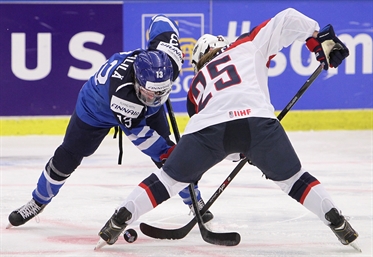Blowouts on the decline
Blowouts on the decline
Scores getting tighter at Women’s Worlds

 MALMO, SWEDEN - MARCH 29: Finland's Riikka Valila #13 faces off against USA's Alex Carpenter #25 during preliminary round action at the 2015 IIHF Ice Hockey Women's World Championship. (Photo by Francois Laplante/HHOF-IIHF Images)
MALMO, SWEDEN - MARCH 29: Finland's Riikka Valila #13 faces off against USA's Alex Carpenter #25 during preliminary round action at the 2015 IIHF Ice Hockey Women's World Championship. (Photo by Francois Laplante/HHOF-IIHF Images)
But let’s look at the big picture.
When Canada trounced Slovakia 18-0 in its opener at the 2010 Olympics in Vancouver, it was the biggest blowout in top-level women’s hockey history.
The result put the host nation in the awkward position of being asked to justify or even apologize for their high-scoring ways in post-game interviews. “This is the Olympic Games, and we prepare and put everything into being the best we can,” said captain Hayley Wickenheiser.
The media scrutiny wasn’t entirely fair, as it ignored the fact that in the early years of Olympic and World Championship men’s hockey, Canada routinely defeated its European opponents by similarly lopsided scores. (How about 47-0 over Denmark in at the 1949 Worlds?) And women’s hockey is still a developing sport.
Fast forward five years, and here’s the upshot: at the 2015 IIHF Ice Hockey Women’s World Championship, blowouts have not been common fare. In fact, they've been in steady decline for the last five years.
What exactly is a blowout?
Let’s define it as a victory by a margin of five or more goals. (Some might claim that three or four would suffice, but everyone can agree on five.) By that definition, the preliminary round in Malmo featured just one blowout: the 9-2 U.S. win over Russia.
That has to be considered an encouraging trend.
It is not simply a product of the IIHF’s decision to promote greater competitive balance by putting the top-ranked teams in Group A and the lower-ranked teams in Group B.
That system was inaugurated at the 2012 Women’s Worlds in Burlington, Vermont. That year, there were four blowouts in the preliminary round. (There has never been a Group B blowout.)
Interestingly, 2012’s Group A included exactly the same teams as this year. The relevant scores were U.S. 9, Canada 2; U.S. 9, Russia 0; Canada 14, Russia 1; U.S. 11, Finland 0.
At the 2013 tournament in Ottawa, there were three blowouts in the preliminary round. They included Canada 13, Switzerland 0; U.S. 5, Switzerland 0; and Canada 8, Finland 0.
At the 2014 Sochi Olympics, Group A witnessed two preliminary-round blowouts: Canada 5, Switzerland 0; and U.S. 9, Switzerland 0.
You don’t need to be Einstein to see what’s going on here.
Now, let’s not get ahead of ourselves. No one is suggesting that true parity has arrived yet. Anyone tracking possession numbers for the U.S. and Canada would agree that the North Americans still own the puck, even against the best bets for bronze.
When, say, Finland lost 4-1 to the Americans, that was more the result of Finnish goaltender Meeri Raisanen making 49 saves than of her teammates keeping the puck out of their own end to any meaningful degree.
But as Canada’s Jayna Hefford said in a very different context after the 18-0 romp over Slovakia, “The score is the score.”
Regardless of the approaches that the second- and third-tier nations are using to stay closer against the North American superpowers, and one another, it’s good to see.
Closer scores mean more exciting hockey, and enrolment in the women’s game is likely to surge when countries outside North America feel they have a better chance of winning.
After all, in men’s hockey, countries like Finland and Switzerland with smaller pools of talent aren’t usually favoured to defeat Canada and the United States. But they always give the North Americans a run for their money, and no one is shocked when they pull off a victory.
If women’s hockey ever gets to the same point, you could hardly ask for more.
Back to Overview























































